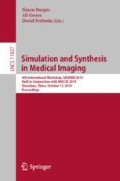Abstract
The ability to synthesise Computed Tomography images - commonly known as pseudo CT, or pCT - from MRI input data is commonly assessed using an intensity-wise similarity, such as an \(L_2\)-norm between the ground truth CT and the pCT. However, given that the ultimate purpose is often to use the pCT as an attenuation map (\(\mu \)-map) in Positron Emission Tomography Magnetic Resonance Imaging (PET/MRI), minimising the error between pCT and CT is not necessarily optimal. The main objective should be to predict a pCT that, when used as \(\mu \)-map, reconstructs a pseudo PET (pPET) which is as close as possible to the gold standard PET. To this end, we propose a novel multi-hypothesis deep learning framework that generates pCTs by minimising a combination of the pixel-wise error between pCT and CT and a proposed metric-loss that itself is represented by a convolutional neural network (CNN) and aims to minimise subsequent PET residuals. The model is trained on a database of 400 paired MR/CT/PET image slices. Quantitative results show that the network generates pCTs that seem less accurate when evaluating the Mean Absolute Error on the pCT (69.68HU) compared to a baseline CNN (66.25HU), but lead to significant improvement in the PET reconstruction - 115a.u. compared to baseline 140a.u.
Access this chapter
Tax calculation will be finalised at checkout
Purchases are for personal use only
References
Pichler, B.J., et al.: Positron emission tomography/magnetic resonance imaging: the next generation of multimodality imaging? In: Seminars in Nuclear Medicine, vol. 38, pp. 199–208. Elsevier (2008)
Ladefoged, C.N., et al.: A multi-centre evaluation of eleven clinically feasible brain PET/MRI attenuation correction techniques using a large cohort of patients. Neuroimage 147, 346–359 (2017)
Burgos, N., et al.: Attenuation correction synthesis for hybrid PET-MR scanners: application to brain studies. IEEE TMI 33(12), 2332–2341 (2014)
Zhu, J.Y., et al.: Unpaired image-to-image translation using cycle-consistent adversarial networks. arXiv preprint arXiv:1703.10593 (2017)
Wolterink, J.M., Dinkla, A.M., Savenije, M.H.F., Seevinck, P.R., van den Berg, C.A.T., Išgum, I.: Deep MR to CT synthesis using unpaired data. In: Tsaftaris, S.A., Gooya, A., Frangi, A.F., Prince, J.L. (eds.) SASHIMI 2017. LNCS, vol. 10557, pp. 14–23. Springer, Cham (2017). https://doi.org/10.1007/978-3-319-68127-6_2
Yang, H., et al.: Unpaired brain MR-to-CT synthesis using a structure-constrained CycleGAN. In: Stoyanov, D., et al. (eds.) DLMIA/ML-CDS -2018. LNCS, vol. 11045, pp. 174–182. Springer, Cham (2018). https://doi.org/10.1007/978-3-030-00889-5_20
Jin, C.B., et al.: Deep CT to MR synthesis using paired and unpaired data. Sensors 19(10), 2361 (2019)
Rupprecht, C., et al.: Learning in an uncertain world: representing ambiguity through multiple hypotheses. In: Proceedings of the IEEE ICCV, pp. 3591–3600 (2017)
Li, W., Wang, G., Fidon, L., Ourselin, S., Cardoso, M.J., Vercauteren, T.: On the compactness, efficiency, and representation of 3D convolutional networks: brain parcellation as a pretext task. In: Niethammer, M., et al. (eds.) IPMI 2017. LNCS, vol. 10265, pp. 348–360. Springer, Cham (2017). https://doi.org/10.1007/978-3-319-59050-9_28
Gibson, E., et al.: NiftyNet: a deep-learning platform for medical imaging. CoRR abs/1709.03485 (2017)
Modat, M., et al.: Fast free-form deformation using graphics processing units. Comput. Methods Programs Biomed. 98(3), 278–284 (2010)
Markiewicz, P.J., et al.: NiftyPET: a high-throughput software platform for high quantitative accuracy and precision PET imaging and analysis. Neuroinformatics 16(1), 95–115 (2018)
Acknowledgment
This work was supported by an IMPACT studentship funded jointly by Siemens and the EPSRC UCL CDT in Medical Imaging (EP/L016478/1). We gratefully acknowledge the support of NVIDIA Corporation with the donation of one Titan V. This project has received funding from Wellcome Flagship Programme (WT213038/Z/18/Z), the Wellcome EPSRC CME (WT203148/Z/16/Z), the NIHR GSTT Biomedical Research Centre, and the NIHR UCLH Biomedical Research Centre.
Author information
Authors and Affiliations
Corresponding author
Editor information
Editors and Affiliations
Rights and permissions
Copyright information
© 2019 Springer Nature Switzerland AG
About this paper
Cite this paper
Kläser, K. et al. (2019). Improved MR to CT Synthesis for PET/MR Attenuation Correction Using Imitation Learning. In: Burgos, N., Gooya, A., Svoboda, D. (eds) Simulation and Synthesis in Medical Imaging. SASHIMI 2019. Lecture Notes in Computer Science(), vol 11827. Springer, Cham. https://doi.org/10.1007/978-3-030-32778-1_2
Download citation
DOI: https://doi.org/10.1007/978-3-030-32778-1_2
Published:
Publisher Name: Springer, Cham
Print ISBN: 978-3-030-32777-4
Online ISBN: 978-3-030-32778-1
eBook Packages: Computer ScienceComputer Science (R0)


